Table of contents
- The best reasons for photovoltaics
- Photovoltaic systems - a comparison
- Meyer Burger - the future of photovoltaic systems
- Charging with electricity from photovoltaic systems
- The following must be taken into account when combining photovoltaics and a charging station
- Conclusion - your own photovoltaic system is worthwhile for you and for the climate
You have already partially or completely converted your company fleet to electric mobility and would now like to supply it with green electricity as self-sufficiently as possible? With a photovoltaic system you not only save money and effectively do something for the climate, you are also independent of strongly fluctuating electricity prices. Find out which type of photovoltaic system is best suited to your needs and what you should look out for when installing solar modules in our blog article.
THE BEST REASONS FOR A PHOTOVOLTAIC SYSTEM
- REDUCE ELECTRICITY COSTS
- RENTABILITY
- SUSTAINABILITY
- SELF-SUFFICIENCY FROM THE ELECTRICITY MARKET
REDUCE ELECTRICITY COSTS
With the electricity produced from your own photovoltaic system, you can significantly and permanently reduce your electricity costs. This is because there is neither a labour charge nor a basic charge for self-generated electricity. This means you avoid all grid charges, i.e. fees to your local grid operator. Before setting up such a system, the electricity consumption, as well as the structural conditions on site and the legal requirements for the construction of the system are analysed in detail. Therefore, you should consult an advisor during the planning phase to keep everything in view. Special attention should be paid to the consumption of your electric vehicles. The electricity consumption necessary for charging your fleet should be included in the calculation for the size of the PV system and the increase in self-consumption. Since a PV system generates the most electricity around midday, which may not be consumed directly, a storage system helps to capture the excess electricity. In this case, this can be your e-vehicles themselves! This way, you can optimise your self-consumption rate and save the most costs.
YOUR OWN PV SYSTEM PAYS OFF
Photovoltaic systems are usually installed on unused roofs or on an open area. By installing solar modules, you can now use these areas sensibly and profitably. The higher your company's own consumption, the faster it pays off monetarily. Smaller systems tend to achieve a higher self-consumption rate. This means that the share of electricity you use in the electricity you produce is very high. Whereas larger PV systems have the advantage that they are specifically cheaper to purchase. The ultimately optimal size of the PV system must be determined individually for each company. The investment in a photovoltaic system, taking into account the current construction costs, has paid for itself after six to ten years.
THEY ACT SUSTAINABLY
A photovoltaic system uses the sun as a renewable energy source and thus contributes to the expansion of renewable energies in Germany. In this way, you not only participate in climate protection and the energy transition, but also ensure a sustainable power supply in your company. A photovoltaic system can save several hundred tonnes of CO2 per year.
SELF-SUFFICIENCY FROM THE ELECTRICITY MARKET
By using your own solar power, you protect yourself for a certain part of your electricity supply against the strongly fluctuating prices on the electricity market. Self-sufficiency not only gives you planning security, but also increases your energy self-sufficiency.
DACH ASSETS
When installing a photovoltaic system on your company roof, the surface of which is usually unused anyway, no building permit is required. With flat roofs, an east-west elevation of the system is common. In this case, the solar modules are mounted in equal parts to the east and west with an inclination of 10 to 15 degrees by means of a mounting system. This way you get more power on your roof. On the other hand, the load on the roof surface is minimised. Because of the aerodynamic shape, the modules are much more protected from the wind. The system is weighted down with additional weight and not fixed to the flat roof by screwing, for example. This type of mounting ensures that no damage occurs to your roof after a long period of use of 20 years and beyond.
With pitched roofs, the PV system is installed parallel to the roof. The solar yield then depends on the inclination and orientation of your roof to the sun. Here, the mounting system is attached directly to the rafters via the roof hook. In principle, you must check whether the structural requirements are met for on-roof systems. The load reserves of the roof must not be exceeded. If this is the case, you should consider a free-standing system. In addition, the grid connection of the roof system is often more complex. It is therefore advisable to consult an expert.
OPEN SPACE SYSTEMS
Such a PV system is best suited for you if you have a high electricity consumption or do not have a load-bearing roof. These systems are usually built directly on your company's property without having to cross public roads with cables.
Due to the low feed-in tariff and the higher cost degression, ground-mounted systems are often planned with a much higher generation capacity. In contrast to a roof-mounted system, a building permit must be applied for for a ground-mounted PV system. In addition, there are increased costs for earthworks and theft protection. However, if you bear this in mind and the open space is not needed for other purposes in the next 20 to 25 years, an open space PV system pays off twice - for you and for the climate. On the one hand, because of the CO2 and cost savings from the solar electricity generated and, on the other hand, because you can create biotopes under the solar modules, for example in the form of a wildflower meadow for bees. These are then mown a maximum of twice a year and are thus also officially recognised.
MEYER BURGER - THE FUTURE OF PHOTOVOLTAIC SYSTEMS
Photovoltaic technology is constantly developing at the moment. China in particular is one of the pioneers in this field. But the latest innovations in solar module production no longer come only from overseas, but also from Saxony. The Photovoltaic machine manufacturer Meyer Burger has presented its new high-performance solar modules at the end of April 2021 in the context of a digital product premiere presentation. The modules, which are manufactured in Germany and weigh less than 20 kilograms each, promise up to 20 percent more power than conventional modules, although the size of the modules remains the same. They also solve the problem of insufficient solar radiation. The concern that bad weather will jeopardise the power supply exists among many interested parties. But Meyer Burger's modules are more weather-independent and even in hot weather or at an unfavourable angle of incidence of the sun, they hardly lose any of their power. In addition, Meyer Burger uses special rear foils that increase the longevity and thus the yield of the modules even more. This is because these foils also convert incident light energy into electricity.

CHARGING WITH ELECTRICITY FROM PHOTOVOLTAIC SYSTEMS
If you want to charge your company fleet with self-generated electricity from your photovoltaic system, you have to consider several aspects when setting up the charging technology. At this point at the latest, detailed advice from specialists is recommended. This way you will know exactly which requirements must be met when installing the technology. For example, it is imperative to ensure that interfaces for communication with the PV system are available. These interfaces are essential for optimising the charging behaviour through an energy management system. A management system is of great importance so that, for example, surplus electricity generated is used to charge e-vehicles. The good thing about this is that you don't have to worry about building an electricity storage system. In this case, your fleet acts as a storage unit, consumes your surplus electricity and thus increases your self-consumption rate.
Before installation, the energy generation capacity of the PV system and the additional power requirement of the charging points must be registered with the responsible distribution grid operator. It is imperative that you consult your local distribution grid operator beforehand. The integration of the individual charging points into the measurement concept of the photovoltaic system must also be ensured.
In order to avoid making mistakes, your planner will be happy to advise you and take over these steps for you.
WHAT TO CONSIDER WHEN COMBINING PHOTOVOLTAICS AND A CHARGING STATION
First of all, it should be said that installing solar modules will save you money over the years. The installation of a Photovoltaic system naturally comes with costs connected. The costs vary depending on the type of system you choose and how large it is. As a rule, a system pays for itself after a few years - as our example shows. You benefit most from the independence from rising electricity prices, grid charges, levies and electricity tax. With the combination of a PV system and charging station, you are also independent and guaranteed sustainable on the road with your e-car. To ensure that the advantages of self-generated PV electricity also apply to charging your e-vehicles and what you need to pay particular attention to here, we explain below.
EEG-UMLAGE
If you generate your own electricity with your PV system and use it for your own supply, you benefit from the so-called own electricity privilege. The EEG levy is reduced to 40 percent. For systems with a maximum generation capacity of 30 kW and a self-consumption of up to 30 megawatt hours per year, the levy can even be waived completely. This also applies to plants that have already been built. However, only the electricity that you consume yourself as a plant operator and use for your production processes or for charging your fleet vehicles or company cars, for example, is exempt.
As soon as the electricity is made available to third parties, the privilege no longer applies and the EEG levy is charged at 100 per cent. For example, for charging quantities that are used by private e-vehicles of employees and guests. This constellation also occurs if additional tenants or external companies on your premises use the solar power via you, e.g. an externally operated company canteen. In all these cases, extensive reporting and payment obligations come into effect.
If these obligations are not observed, the consequence is that the entire electricity generated in the respective calendar year is also subject to the EEG levy retroactively. Therefore, if you also want to use the solar electricity in constellations with third parties, all electricity quantities must be clearly distinguished from one another for the purposes of levying the EEG surcharge.
This requires complex and expensive metering concepts as well as a monthly obligation to report all quantities to the transmission system operator. The quantities of generation, feed-in and use of your electricity by third parties must be distinguished from each other. What has to be observed in detail is explained in the Guideline of the Federal Network Agency explains on 85 pages.
The difficulties associated with a delimitation of the charging electricity taken from third parties can be circumvented by concluding ordinary electricity supply contracts on the market for the third party consumers. This means that this electricity is made available from the grid via independently billable metering points (market locations).
In the context of the charging infrastructure, this means that the charging stations intended for charging private employee and guest vehicles should ideally not be supplied from the PV system and should be supplied with electricity from the public grid via a separate electricity supply contract. In order not to lose track of this complex topic or even jeopardise the entire own power privilege, we recommend consulting an advisor here as well.
ELECTRICITY TAX
The electricity tax is similar to the own-use electricity privilege. Electricity generated from renewable energy sources in plants with a nominal electrical output of up to two megawatts and which is withdrawn by the plant operator for self-consumption in the spatial context of the plant is exempt from electricity tax.
Unfortunately, this privilege explicitly does not apply to electricity used for charging electric vehicles (see §9b para. 1). However, according to sections 9b and 10 of the Electricity Tax Act, an exemption is possible under certain circumstances (see also chart). Here, too, it is therefore indispensable to clearly distinguish the different electricity quantities and to report the quantities. However, the requirements here, e.g. for measurement, are less stringent than for the EEG. We also recommend that you consult a tax advisor.
| Company | ||||
| Power supply | Electricity from renewable own generation | Public grid | ||
| Charging station users | Guests and employees | Fleet / company car drivers | Guests and employees | Fleet / company car drivers |
| Electricity tax | Yes | Yes* | Yes | Yes |
*Exemption according to §§9b and 10 possible
CONCLUSION - YOUR OWN PHOTOVOLTAIC SYSTEM IS WORTHWHILE FOR YOU
If you have free, unused space on your roof or your company's property and a partial or complete electrified fleet property, the installation of a photovoltaic system is definitely worthwhile. You can thereby
- AUTARK
- CLIMATE NEUTRAL AND
- FREE OF CHARGE
consume your own electricity. In order to make the best possible use of the various advantages of a PV system, including the electricity tax savings and the reduced EEG apportionment, there are a number of things to consider, especially when combining the system with charging technology. Therefore, it is imperative that you contact a professional who can support you with the complete planning and implementation. Our colleagues at SachsenEnergie will be happy to answer any questions you may have.
If you are a small or medium-sized company in Saxony and are interested in the promotion of e-cars and charging stations, you will find information in our Electric car promotion checklist a practical aid to print out. In our extensive Whitepaperwhich you can download free of charge, you will also find a wealth of information on charging infrastructure and best practices from Saxony. Do you have any questions or an idea for a topic? Then please send us an e-mail to .





